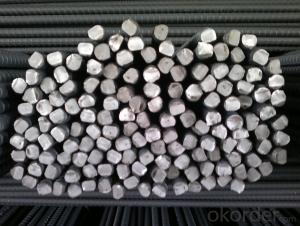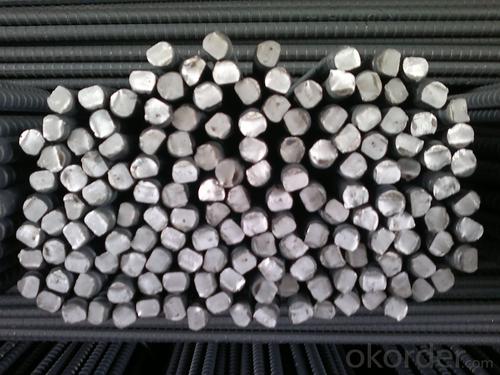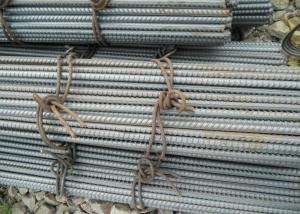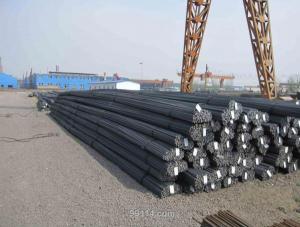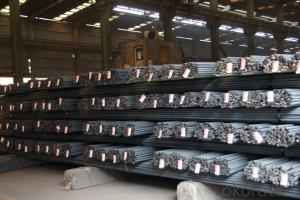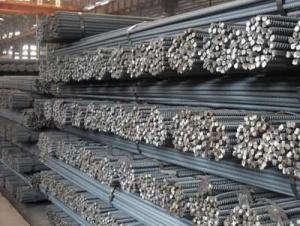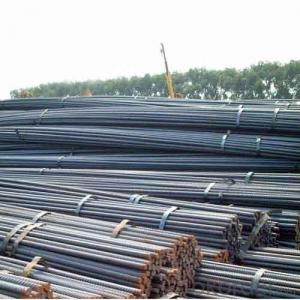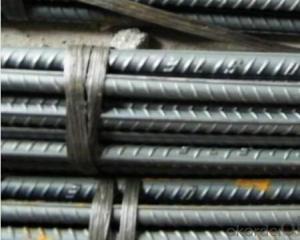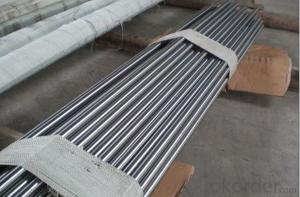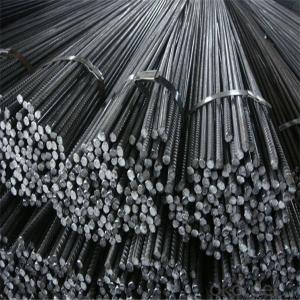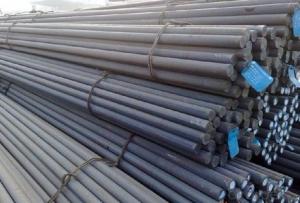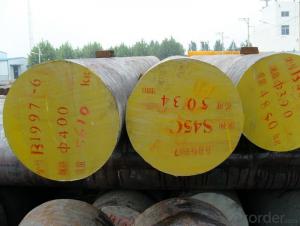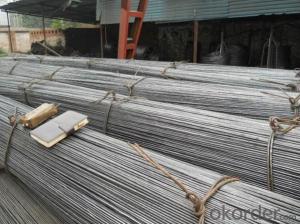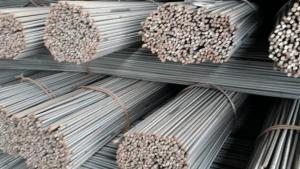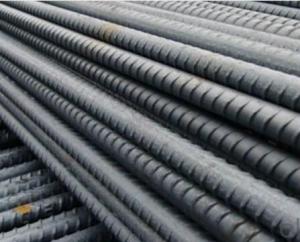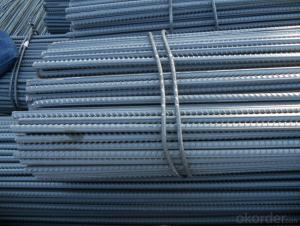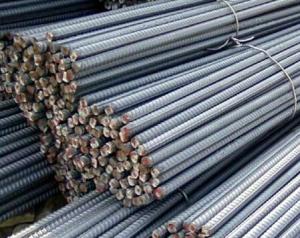HRB400, HRB500 Deformed Steel Rebars for Constrution
- Loading Port:
- Tianjin
- Payment Terms:
- TT OR LC
- Min Order Qty:
- -
- Supply Capability:
- 200000 m.t./month
OKorder Service Pledge
OKorder Financial Service
You Might Also Like
Specifications of HRB400, HRB500 Deformed Steel Rebars for Constrution:
Standard | GB UK USA | HRB335 HRB400 HRB500 G460B, B500A, B500B,B500C GR40, GR60 | |
Diameter | 6mm,8mm,10mm,12mm,14mm,16mm,18mm,20mm, 22mm,25mm,28mm,32mm,36mm,40mm,50mm | ||
Length | 6M, 9M,12M or as required | ||
Payment term | TT or L/C | ||
Trade terms | FOB, CFR, CIF | ||
Application | Building, construction | ||
Each bundle weight | 2-3MT, or as required | ||
Type | Hot rolled steel rebar | ||
Brand name | DRAGON | ||
Theoretical weight and section area of each diameter as below for your information:
Diameter(mm) | Section area (mm²) | Mass(kg/m) | Weight of 12m (kg) | Pcs/ton |
6 | 28.27 | 0.222 | 2.664 | 375.38 |
8 | 50.27 | 0.395 | 4.74 | 210.97 |
10 | 78.54 | 0.617 | 7.404 | 135.06 |
12 | 113.1 | 0.888 | 10.656 | 93.84 |
14 | 153.9 | 1.21 | 14.52 | 68.87 |
16 | 201.1 | 1.58 | 18.96 | 52.74 |
18 | 254.5 | 2.00 | 24 | 41.67 |
20 | 314.2 | 2.47 | 29.64 | 33.74 |
22 | 380.1 | 2.98 | 35.76 | 27.96 |
25 | 490.9 | 3.85 | 46.2 | 21.65 |
28 | 615.8 | 4.83 | 57.96 | 17.25 |
32 | 804.2 | 6.31 | 75.72 | 13.21 |
36 | 1018 | 7.99 | 98.88 | 10.43 |
40 | 1257 | 9.87 | 118.44 | 8.44 |
50 | 1964 | 15.42 | 185.04 | 5.40 |
Deformed Steel Rebar in warehouse
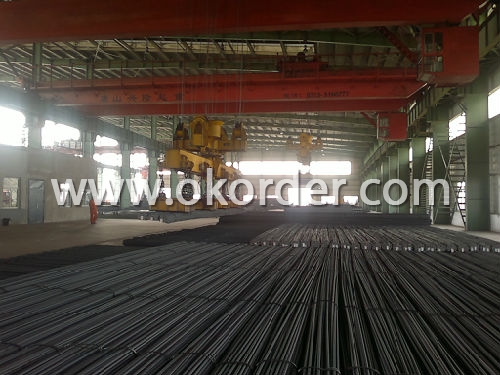
Usage and Applications of HRB400, HRB500 Deformed Steel Rebars for Constrution:
Deformed bar is widely used in buildings, bridges, roads and other engineering construction. Big to highways, railways, bridges, culverts, tunnels, public facilities such as flood control, dam, small to housing construction, beam, column, wall and the foundation of the plate, deformed bar is an integral structure material. With the development of world economy and the vigorous development of infrastructure construction, real estate, the demand for deformed bar will be larger and larger..
Packaging & Delivery of HRB400, HRB500 Deformed Steel Rebars for Constrution:
Packaging Detail: products are packed in bundle and then shipped by container or bulk vessel, deformed bar is usually naked strapping delivery, when storing, please pay attention to moisture proof. The performance of rust will produce adverse effect.
Delivery Detail: within 45 days after received advanced payment or LC.
Label: to be specified by customer, generally, each bundle has 1-2 labels
Note:
1. Our products are produced according to national standard (GB), if not, supply according to national standards (GB) or agreement as customer required.
2. Other Grade and Standard Deformed Steel Bar we can supply:
Grade: GR40/GR60, G460B/B500A/B500B/B500C,BST500S
Standard: ASTM, BS, DIN
The Minimum Order Quantity of these products is high, and need to be confirmed.
3. We can not only supply Deformed Steel Bar; if you need anything about building materials, please contact us for further information.
4. Please send us your detail specifications when inquire. We will reply to you as soon as possible. We sincerely hope we can establish a long stable business relationship.
- Q: Can steel rebars be used in tunnels and underground structures?
- Yes, steel rebars can be used in tunnels and underground structures. They are commonly used to reinforce and strengthen the concrete used in these structures, providing additional stability and load-bearing capacity.
- Q: Are steel rebars suitable for use in earthquake-prone regions?
- Yes, steel rebars are suitable for use in earthquake-prone regions. Steel rebars are widely used in construction due to their high tensile strength and ductility, which allows them to absorb and distribute seismic forces during an earthquake. Additionally, steel rebars can be reinforced with epoxy coatings or corrosion-resistant materials, increasing their durability and longevity in earthquake-prone areas.
- Q: What are the different types of steel rebars used in road constructions?
- There are several types of steel rebars that are commonly used in road constructions. These include: 1. Mild steel rebars: These are the most commonly used type of rebars in road constructions. They are made from low carbon steel and have a smooth surface. Mild steel rebars are known for their durability and strength, making them suitable for various road construction applications. 2. High-strength rebars: These rebars are made from high-strength steel, which has a higher yield strength compared to mild steel rebars. High-strength rebars are used in road constructions where greater load-bearing capacity is required, such as in bridges and highways. 3. Epoxy-coated rebars: These rebars are coated with epoxy resin to improve their corrosion resistance. Epoxy-coated rebars are commonly used in road constructions in areas where there is exposure to moisture and chemicals, such as coastal regions. 4. Galvanized rebars: These rebars are coated with a layer of zinc to provide corrosion resistance. Galvanized rebars are particularly suitable for road constructions in areas with high humidity or where the risk of corrosion is high. 5. Stainless steel rebars: These rebars are made from stainless steel, which is highly resistant to corrosion. Stainless steel rebars are commonly used in road constructions where long-term durability and resistance to corrosion are essential, such as in tunnels and underground structures. It is important to select the appropriate type of steel rebar for road constructions based on the specific requirements of the project, including load-bearing capacity, exposure to corrosion, and environmental conditions. Consulting with structural engineers and adhering to local construction codes and standards is crucial to ensure the successful implementation of road construction projects.
- Q: Can steel rebars be used in high-security facility construction?
- Yes, steel rebars can be used in high-security facility construction. Steel rebars provide enhanced strength and durability, making them suitable for reinforcing structures in high-security facilities where robustness and resistance against external threats are crucial.
- Q: Can steel rebars be used in structures with high alkaline environments?
- Yes, steel rebars can be used in structures with high alkaline environments. Steel rebars are commonly used in concrete structures and are designed to withstand various environmental conditions, including high alkaline environments. However, it is essential to ensure that the appropriate type of steel rebar is selected to prevent corrosion and maintain structural integrity in such conditions.
- Q: Can steel rebars be used in the construction of tunnels?
- Yes, steel rebars can be used in the construction of tunnels. Steel rebars are commonly used as reinforcement in concrete structures, including tunnels. They provide strength and stability to the concrete, making it capable of withstanding the loads and stresses experienced in tunnel construction.
- Q: What is the purpose of stirrups in steel rebar reinforcement?
- Stirrups in steel rebar reinforcement serve to offer lateral support and improve the overall structural integrity of reinforced concrete components. Typically made of bent steel bars, stirrups are positioned around the longitudinal rebar within concrete columns, beams, or slabs. One of the primary functions of stirrups is to prevent buckling or bending of the longitudinal rebar caused by external forces like compression, tension, or shear. By enclosing the rebar with closely spaced stirrups, the strength and stability of the reinforced concrete element are significantly increased. Additionally, stirrups play a crucial role in resisting shear forces, which arise when a structure is subjected to lateral loads or earthquakes. These forces can lead to cracking and failure of the concrete. However, stirrups distribute shear stresses more evenly, effectively impeding the formation and propagation of cracks. Moreover, stirrups enhance the bond between the rebar and concrete by providing extra contact area. This, in turn, results in improved load transfer and prevents slippage between the rebar and the surrounding concrete. To summarize, stirrups in steel rebar reinforcement aim to enhance the structural strength, stability, and durability of reinforced concrete elements. They offer lateral support, resist bending and shear forces, and enhance the bond between the rebar and concrete. By incorporating stirrups into the reinforcement design, engineers can ensure that the concrete structure can withstand various external loads and maintain its integrity over time.
- Q: What is the process of epoxy-coating steel rebars?
- To achieve a durable and corrosion-resistant coating on steel rebars, several steps are involved in the process of epoxy-coating. Here is a general overview of the process: Firstly, the steel rebars undergo thorough surface preparation to eliminate any rust, oil, or other contaminants. This can be accomplished through techniques such as sandblasting or chemical cleaning. Once the rebars are cleaned, a primer is applied to enhance adhesion between the steel surface and the epoxy coating. Additionally, the primer provides an extra layer of protection against corrosion. After the primer has dried, the epoxy coating is applied to the rebars. This can be done using various methods, including spray application or immersing the rebars in an epoxy tank. Following the application of the epoxy coating, the rebars are left to cure. This controlled process allows the coating to harden and fully bond with the steel surface. The curing time varies depending on the specific epoxy and environmental conditions. Once the rebars have cured, a thorough inspection is conducted to ensure the uniform application of the epoxy coating and that it meets the required specifications. This inspection may involve visual checks, adhesion tests, and measurements of coating thickness. After passing inspection, the epoxy-coated steel rebars are packaged and stored in a controlled environment to protect them from damage or further contamination. It is important to note that the specific process may vary depending on factors such as the manufacturer, project requirements, and the type of epoxy coating used. Following industry standards and guidelines is crucial to ensure the quality and effectiveness of the epoxy-coated steel rebars.
- Q: How are steel rebars protected from rusting?
- Steel rebars undergo corrosion protection to prevent rusting. Various methods are used for this purpose, including the application of protective coatings, galvanization, and the utilization of corrosion inhibitors. One effective method is the utilization of protective coatings, which act as a barrier between the rebar and its surroundings. By doing so, they prevent moisture and oxygen from reaching the steel surface. These coatings can be applied using techniques like epoxy coating, fusion-bonded epoxy (FBE) coating, or zinc-rich paint. These coatings exhibit exceptional adhesion and durability, ensuring long-term protection against rust. Galvanization is another method employed, which involves coating the rebar with a layer of zinc. Zinc serves as a sacrificial anode, corroding in place of the steel when exposed to moisture and oxygen. This sacrificial corrosion process aids in safeguarding the steel from rusting. Galvanized rebars are often used in environments with high moisture levels, such as coastal areas or regions with high humidity. Corrosion inhibitors are also utilized to protect steel rebars. These inhibitors are chemicals added to the concrete mix or directly applied to the rebar surface. They function by creating a protective layer on the steel surface, inhibiting the corrosion process. Corrosion inhibitors are particularly valuable in scenarios where the rebar may encounter chloride ions, which accelerate the corrosion of steel. In conclusion, a combination of these methods is frequently employed to ensure comprehensive protection against rusting for steel rebars. This guarantees the durability and structural integrity of reinforced concrete structures like buildings, bridges, and highways.
- Q: How are steel rebars bent during construction?
- Steel rebars are bent during construction using specialized tools and equipment. The process involves several steps to ensure the rebars are bent accurately and to the required specifications. First, the rebars are selected based on the design and structural requirements of the project. The rebars are typically made of carbon steel and come in various sizes and lengths. They are usually straight and need to be bent according to the specific shape and dimensions required for the construction. To bend the rebars, construction workers use a bending machine or a hydraulic bender. These machines have a set of rollers or dies that apply pressure to the rebar, bending it into the desired shape. The machine is adjusted to the required angle and radius of the bend. Before bending, the rebars are marked with measurements and reference points to ensure accuracy. The operator places the rebar into the bending machine, aligning it with the reference points. The machine is then activated, and the rollers or dies apply force to the rebar, gradually bending it to the desired shape. For complex bends or shapes, multiple bends may be required. In such cases, the rebar is bent incrementally, with the operator adjusting the machine after each bend to achieve the desired shape. It is important to note that rebars have specific bending limits to prevent them from breaking or losing their structural integrity. Construction workers must adhere to these limits and ensure that the rebars are not over-bent, as it could compromise the strength and safety of the structure. Overall, the process of bending steel rebars during construction involves using specialized equipment, careful measurements, and skilled operators to achieve the required shapes and dimensions for the project.
Send your message to us
HRB400, HRB500 Deformed Steel Rebars for Constrution
- Loading Port:
- Tianjin
- Payment Terms:
- TT OR LC
- Min Order Qty:
- -
- Supply Capability:
- 200000 m.t./month
OKorder Service Pledge
OKorder Financial Service
Similar products
Hot products
Hot Searches
Related keywords
